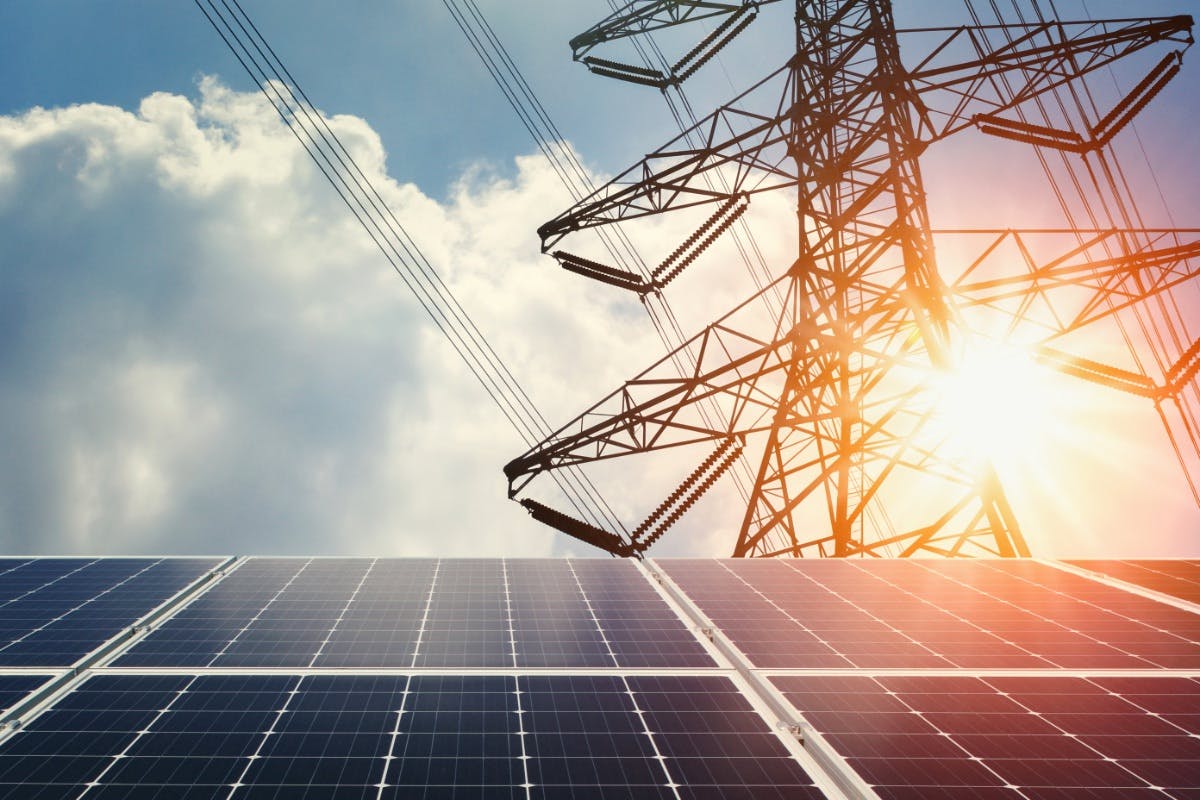How Solar Power And The Grid Work Together
Last edited

Author
Cory O'Brien
Senior Director - Growth Marketing

Editor
Ryan Barnett
SVP, Policy & New Market Development

The popularity of producing clean energy with your own solar power system continues to increase. As more people are going solar, utility companies are using programs like net metering to help integrate solar power and the grid.
We believe the solar power industry and the electric grid can enjoy mutual benefits through increased energy supply that stabilizes when, where, and how electricity is generated and distributed.
When thinking about solar power, it’s helpful to understand how home solar, solar companies, utilities, and the power grid can all work together to better serve the electricity needs of the population.
See how much you can save with home energy changes
How Does the Electricity Grid Work?
The day-to-day operations of the electricity grids in the United States are rather straightforward, as utility companies have used the same top-down model for over a century. Here is a breakdown of the process:
- Generation: Big power plants generate power. Step-up transformers increase the voltage of that power to the very high voltages needed for transmission.
- Transmission: The generated power travels long distances over high-voltage transmission lines.
- Conversion: At local facilities, the high-voltage power flows through step-down transformers to become lower voltage.
- Distribution: Distribution wires carry lower voltage electricity from transformers to homes and businesses in the area.
- Transformation: The transformers on power poles further lower the voltage to consumption level.
- Connection: Electricity enters your home or business via the electricity meter which keeps track of consumption.
The Relationship Between Your Solar Power System and the Electric Grid
Despite what people often think, going solar doesn't necessarily mean you’re going to be off-the-grid. In fact, no conversation about how solar energy works would be complete without discussing the relationship between solar power and the grid. This is because the vast majority of homes that install solar panels still draw power from the grid that the utility companies help operate.
So why does your home need power from the grid after solar panel installation? The simple answer is that remaining connected to the grid allows your home to draw additional power when solar panels can’t generate enough electricity, including nights and cloudy days. At the same time, your home can also push additional power back into the grid when your home doesn’t need all of the electricity being generated, such as in the middle of a sunny day when everyone is away from the house.
For most homes, your residential solar power system will probably be grid-tied, more commonly known as on-the-grid. When grid-tied, your solar panel system is connected to the grid via a bi-directional electricity meter. It measures the excess power you send to the grid when your solar panels produce more than you need, and the amount of energy you pull from the grid when your solar panel system doesn't generate enough.
If you are truly off-grid, you are not connected in any way to the local grid. That means there are no distribution wires from the power line to your home. You are entirely reliant on the electricity your solar panels produce to meet your energy needs, and there’s no backup in case of a power outage or other issue.
Off-grid living requires you to take some extra steps to be successfully disconnected from the grid, including generating energy from multiple sources, solar power battery storage, and home design that minimizes excess energy usage.
Net Metering Credits Homes That Add Solar Power To The Grid
A net metering program credits homeowners when they generate electricity and send that excess generation to the grid. If your utility company offers net metering and you participate in the program, every excess kilowatt-hour (kWh) of energy you send to the grid counts as credit towards your future energy consumption.
The more excess power generated and fed to the electricity grid, the more credit you will earn, which will help offset the energy you use when your solar power system doesn't create enough electricity to power your home. Thus, your electricity bill is based on the total electricity you used, relative to the total energy you generated and fed to the grid.
Most people consume more electricity in the morning when getting ready for the day, and in the evening when they get home from work. Net metering ensures you get the most value from the energy generated by your solar power system, especially in the afternoon, which happens to be when you typically consume less electricity.
The excess energy you generate goes to the grid, earning you credit while also helping the grid by reducing electricity demand. Keep in mind that electricity demand is usually highest during the day when most businesses are open, so feeding your surplus energy back to the grid helps meet this increased demand.
If you wish to participate in net metering, make sure to find out if it is available in your area and how it will help offset your usage. One easy way to do so is with Palmetto’s Free Solar Savings Estimate. Once you find out how much you could save by going solar, just enter your contact information and one of our solar experts can review the programs that are available in your area, and help you understand how to take advantage of them.
Time-of-Use Plans Align Rates with Demand on the Grid
Time-of-use rates allow utility companies to adjust the rate of pay for electricity over the course of the day. When demand goes up, rates go up as well, and when demand drops, homeowners can pay less for the electricity they need.
On a time-of-use rate plan, your photovoltaic (PV) system's excess solar energy generation in the middle of the day is usually less valuable than the power you draw from the grid at night. During peak sun hours, solar-powered homes often add more electricity to the grid than they use, so utility companies don’t want to pay as much for that electricity because of the increased supply.
When the sun goes down, utilities can then charge homeowners more per kWh for the electricity they draw from the grid as demand outpaces supply.
If you live in an area with time-of-use rate structures, you may be able to save more money by storing the excess energy generated by your solar panels during peak sun hours, and then using your solar power storage later in the day when rates are highest. This requires the installation of battery storage as part of your solar power system, which can help you save more money by circumventing the peak utility charges at night.
See how much you can save by going solar with Palmetto
How Solar Power Helps the Grid
While there is some interaction between solar power and the grid operated by utility companies, it can often seem like they operate independently from each other. However, installing solar panels on your home can actually help the electric grid, so we think that the relationship between solar homes and the electric grid should be strengthened.
From helping lower the electricity demand and reducing grid stress to increasing generation, going solar helps support the grid in various ways:
Solar Power Smooths Out The Grid’s Demand Curve
The demand curve is how the energy industry describes the increase and decrease in consumer demand for electricity relative to supply in a given day.
By adding electricity to the grid with your solar panels, you reduce the peaks of that curve because people can use the energy you generated without the utility companies ramping up their power plants to meet consumer demand. Thus, the grid doesn’t experience massive spikes in demand because solar energy generation is available from grid-tied panels.
Solar Power Reduces Grid Stress
When you go solar, you help reduce the amount of electricity that needs to be moved across transmission and distribution lines. Solar energy lowers the stress on the electricity grid because most solar energy stays in the area where it’s generated, and doesn’t need to be transmitted long distances. As a result, the transmission lines get a breather during the hottest parts of the day when demand is highest.
Solar Power Helps Lower The Cost of Grid Upgrades and Maintenance
Going solar helps offset the need for spending on both new generation and new transmission infrastructure. When solar power enters the grid (instead of energy from fossil fuels) the reduced grid stress translates into lower operating costs for utility companies thanks to reduced maintenance expenses. The less money the grid needs to spend to fix problems, the less you have to pay on your utility bills over time to cover that expense.
How Solar Energy and the Electricity Grid Don't Get Along
Even with the benefits they provide, many utility companies aren’t excited about the growth in homes with solar power systems. Afraid of losing revenue and influence in the energy industry, the people in charge of the electricity grid have started looking for ways to make going solar more challenging for people. Their perceived problems with the recent growth of solar power and the grid boil down to five factors:
Solar Energy Reduces Income for Utilities
Homeowners with rooftop solar panels purchase less energy from the grid and pay less to the utility companies. People who participate in net metering programs can sometimes produce enough surplus electricity to offset the majority of their utility bills, so they end up paying almost nothing to their utility company.
While this is a good thing for consumers, the environment, and the long-term health of the grid, some utility companies are concerned about how rooftop solar may reduce their potential earnings in the future.
Solar Energy Increases The Fear of Competition
In many places, the utility company has basically operated as a monopoly for many years, which means they haven’t had to compete in the open market to “win” their customers. Now that solar panels give homeowners an alternative to how they get power, utilities have to compete in ways they’ve never had to in the past.
Furthermore, as the cost of solar decreases and efficiency increases, the technology approaches grid parity, which is when solar power costs less than, or equal to, the cost of electricity from conventional fossil fuel sources like coal, oil, and natural gas. The goal of grid parity is to make solar more affordable than fossil fuel power, even without tax credits or other incentives, which would drastically increase the competitiveness of clean energy.
This increase in solar installations worries utility companies because they view it as consumers paying less for grid operations. In many places, the utilities are so concerned about consumers becoming power producers that they’re seeking additional restrictions on solar energy production and net metering to prevent that competition.
Solar Energy Doesn't Provide Predictable Generation
While solar panel systems can generate a lot of electricity and add it to the grid, they can't do so all the time. When the sun isn’t shining, energy production decreases, so there’s no way to just ‘turn on’ more solar energy like you can with fossil fuel electricity generation.
Solar Energy and The Grid are Built Differently
The current power grid is designed to support electricity transmission that starts at large power plants and gets distributed out to consumers. Compared to the grid’s top-down model, solar panels are designed to work using a distributed model.
Distributed generation focuses on electricity production at or near where it will be used, with a big focus on the electricity created by photovoltaics. While energy from solar panels can be fed to the electric grid to support clean power and reliable delivery, the current grid configuration needs some improvement for the two distribution infrastructures to work seamlessly together.
Solar Energy Uses the Grid Without Paying for It
On a grid-tied system, homeowners with rooftop solar panels generate the electricity they need, feed the surplus to the grid, and only turn to the grid when their systems aren't generating enough to meet their needs. Utility companies feel they need to be allowed to recover the costs associated with maintaining the grid infrastructure that solar-powered homeowners stay connected to, even if they don’t pull power from it all the time.
At Palmetto, we feel that no customer wanting to go solar and participate in net metering should be penalized. Solar energy helps the planet by reducing our reliance on fossil fuels, and home solar plays a big role in easing pressure on the aging grid by lowering overall electricity demand.
How the Utility Grid and Solar Energy Companies Can Work Together
The world is getting more focused on using renewable energy sources for a pollution-free planet, but the grid is not yet ready to fully integrate renewable energy technologies. A significant upgrade is necessary for that to happen, and can be made easier if solar companies and utility companies join hands. (It’s a concept we call the New Utility Revolution.)
The utility companies should be ready to accept that the time for a change is here, and look for ways to upgrade the current top-down system to support distributed generation. This new smart grid has the potential to benefit solar homeowners, utility companies, and the grid at the same time, but only if everyone works together for the greater good.
Embracing distributed generation, focusing on increasing solar generation, and investing in solar technologies are some of the things the utilities should consider implementing to help solar power and the grid work together.
Focus on Increasing Solar Generation
The aging US electricity grid already struggles to meet the rising energy demands of modern homes filled with electricity-powered devices. With consumption increasing by the day, a shift to renewable energy to address that additional demand is more viable and timely. Instead of seeing solar companies as competitors, utility companies should start seeing how they can empower them to produce more clean energy in the future.
Embrace Distributed Energy Generation
Utility companies feel disadvantaged by the growth of solar technologies. Both the current regulations and the new ones they seek are a major blow to increasing and improving clean energy generation. Instead of ignoring the benefits of solar energy and its growing popularity, utility companies should adapt by creating a conducive environment for their counterparts, working together to create and distribute the electricity that we all need.
Invest in Solar Technology
Renewable energy sources like solar panels are the wave of the future, and that won’t change any time soon. For that reason alone, utilities need to think of ways to be part of the trend, instead of working against it. This starts with efforts like developing utility-scale solar, increasing net metering options, and improving the grid to allow for better distributed energy generation.
Utility companies can also invest in solar companies and solar technologies, setting themselves up to share in the success of this clean energy revolution, instead of just seeing those companies as competition.
Key Takeaways
Solar power is a key element of the greater renewable energy movement that’s helping to mitigate climate change. While solar companies work tirelessly to develop better solar technologies, utility companies can take steps to work with, and adapt to this new norm. Programs like net metering and time-of-use rates are helping solar power and the grid work better together, but more can be done to adapt to the needs of solar-powered homes.
Solar power helps the grid in many different ways, such as smoothing out the demand curve, reducing grid stress, and lowering the cost of grid upgrades and maintenance. Grid operators need to find ways to keep up with modern solar technologies to better serve the electricity needs of the population. People want to go solar, and utility companies should be proactive to this trend, not reactive or combative.
If you are interested in going solar to lower your utility bills and help the electricity grid, Palmetto can help you achieve those goals. Our experts will analyze your home’s energy needs, recommend the best solar energy system for you, and guide you through the entire installation process from start to finish.


